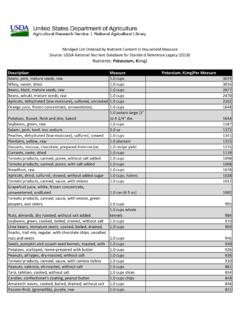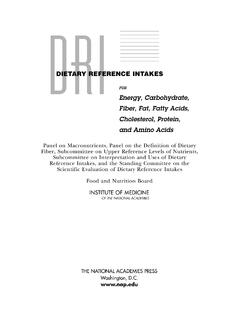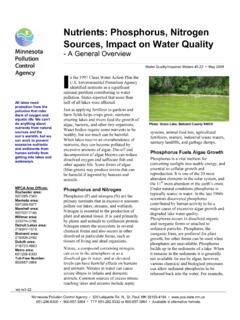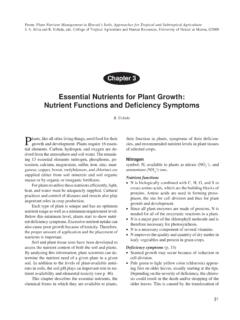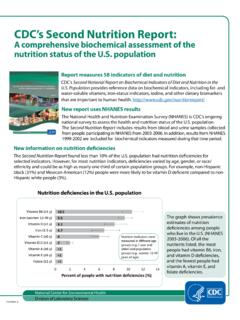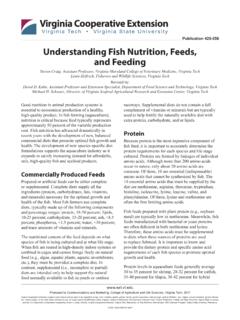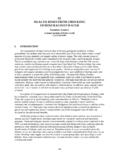Transcription of Dietary Reference Intakes: Macronutrients
1 Dietary Reference Intakes: Macronutrients nutrient Function Life Stage Group RDA/AI* g/d AMDR Selected Food Sources Adverse effects of excessive consumption Carbohydrate Total digestibleRDA based on its role as the primary energy source for the brain; AMDR based on its role as a source of kilocalories to maintain body weightInfants 0 6 mo 7 12 mo Children 1 3 y 4 8 y Males 9 13 y 14 18 y 19 30 y 31-50 y 50-70 y > 70 y Females 9 13 y 14 18 y 19 30 y 31-50 y 50-70 y > 70 y Pregnancy 18 y 19-30y 31-50 y Lactation 18 y 19-30y 31 50 y 60* 95* 130 130 130 130 130 130 130 130 130 130 130 130 130 130 175 175 210 210 210 NDbND 45-65 45-65 45-65 45-65 45-65 45-65 45-65 45-65 45-65 45-65 45-65 45-65 45-65 45-65 45-65 45-65 45-65 45-65 45-65 45-65 Starch and sugar are the major types of carbohydrates. Grains and vegetables (corn, pasta, rice, potatoes, breads) are sources of starch.
2 Natural sugars are found in fruits and juices. Sources of added sugars are soft drinks, candy, fruit drinks, and desserts. While no defined intake level at which potential adverse effects of total digestible carbohydrate was identified, the upper end of the adequate macronutrient distribution range (AMDR) was based on decreasing risk of chronic disease and providing adequate intake of other nutrients. It is suggested that the maximal intake of added sugars be limited to providing no more than 25 percent of energy. Total Fiber Improves laxation, reduces risk of coronary heart disease, assists in maintaining normal blood glucose Infants 0 6 mo 7 12 mo Children 1 3 y 4 8 y Males 9 13 y 14 18 y 19 30 y 31-50 y 50-70 y > 70 y Females 9 13 y 14 18 y 19 30 y 31-50 y 50-70 y > 70 y Pregnancy 18 y 19-30y 31-50 y Lactation 18 y 19-30y 31 50 y ND ND 19* 25* 31* 38* 38* 38* 30* 30* 26* 26* 25* 25* 21* 21* 28* 28* 28* 29* 29* 29* Includes Dietary fiber naturally present in grains (such as found in oats, wheat, or unmilled rice) and functional fiber synthesized or isolated from plants or animals and shown to be of benefit to health Dietary fiber can have variable compositions and therefore it is difficult to link a specific source of fiber with a particular adverse effect, especially when phytate is also present in the natural fiber source.
3 It is concluded that as part of an overall healthy diet, a high intake of Dietary fiber will not produce deleterious effects in healthy individuals. While occasional adverse gastrointestinal symptoms are observed when consuming some isolated or synthetic fibers, serious chronic adverse effects have not been observed. Due to the bulky nature of fibers, excess consumption is likely to be self-limiting. Therefore, a UL was not set for individual functional fibers. NOTE: The table is adapted from the DRI reports, see It represents Recommended Dietary Allowances (RDAs) in bold type, Adequate Intakes (AIs) in ordinary type followed by an asterisk (*). RDAs and AIs may both be used as goals for individual intake. RDAs are set to meet the needs of almost all (97 to 98 percent) individuals in a group. For healthy breastfed infants, the AI is the mean intake. The AI for other life stage and gender groups is believed to cover the needs of all individuals in the group, but lack of data prevent being able to specify with confidence the percentage of individuals covered by this intake.
4 A Acceptable Macronutrient Distribution Range (AMDR)a is the range of intake for a particular energy source that is associated with reduced risk of chronic disease while providing intakes of essential nutrients. If an individual consumes in excess of the AMDR, there is a potential of increasing the risk of chronic diseases and/or insufficient intakes of essential nutrients. bND = Not determinable due to lack of data of adverse effects in this age group and concern with regard to lack of ability to handle excess amounts. Source of intake should be from food only to prevent high levels of intake. SOURCE: Dietary Reference Intakes for Energy, Carbohydrate. Fiber, Fat, Fatty Acids, Cholesterol, Protein, and Amino Acids (2002/2005). This report may be accessed via Reference Intakes: Macronutrients nutrient Function Life Stage Group RDA/AI* g/d AMDRaSelected Food Sources Adverse effects of excessive consumption Total Fat Energy source and when found in foods, is a source of n-6 and n-3 polyunsaturated fatty acids.
5 Its presence in the diet increases absorption of fat soluble vitamins and precursors such as vitamin A and pro-vitamin A carotenoids. Infants 0 6 mo 7 12 mo Children 1 3 y 4 8 y Males 9 13 y 14 18 y 19 30 y 31-50 y 50-70 y > 70 y Females 9 13 y 14 18 y 19 30 y 31-50 y 50-70 y > 70 y Pregnancy 18 y 19-30y 31-50 y Lactation 18 y 19-30y 31 50 y 31* 30* 30-40 25-35 25-35 25-35 20-35 20-35 20-35 20-35 25-35 25-35 20-35 20-35 20-35 20-35 20-35 20-35 20-35 20-35 20-35 20-35 Butter, margarine, vegetable oils, whole milk, visible fat on meat and poultry products, invisible fat in fish, shellfish, some plant products such as seeds and nuts, and bakery products. While no defined intake level at which potential adverse effects of total fat was identified, the upper end of AMDR is based on decreasing risk of chronic disease and providing adequate intake of other nutrients. The lower end of the AMDR is based on concerns related to the increase in plasma triacylglycerol concentrations and decreased HDL cheolesterol concentrations seen with very low fat (and thus high carbohydrate) diets.
6 N-6 polyunsaturated fatty acids (linoleic acid) Essential component of structural membrane lipids, involved with cell signaling, and precursor of eicosanoids. Required for normal skin function. Infants 0 6 mo 7 12 mo Children 1 3 y 4 8 y Males 9 13 y 14 18 y 19 30 y 31-50 y 50-70 y > 70 y Females 9 13 y 14 18 y 19 30 y 31-50 y 50-70 y > 70 y Pregnancy 18 y 19-30y 31-50 y Lactation 18 y 19-30y 31 50 y * * 7* 10* 12* 16* 17* 17* 14* 14* 10* 11* 12* 12* 11* 11* 13* 13* 13* 13* 13* 13* NDbND 5-10 5-10 5-10 5-10 5-10 5-10 5-10 5-10 5-10 5-10 5-10 5-10 5-10 5-10 5-10 5-10 5-10 5-10 5-10 5-10 Nuts, seeds, and vegetable oils such as soybean, safflower, and corn oil. While no defined intake level at which potential adverse effects of n-6 polyunsaturated fatty acids was identified, the upper end of the AMDR is based the lack of evidence that demonstrates long-term safety and human in vitro studies which show increased free-radical formation and lipid peroxidation with higher amounts of n-6 fatty acids.
7 Lipid peroxidation is thought to be a component of in the development of atherosclerotic plaques. NOTE: The table is adapted from the DRI reports, see It represents Recommended Dietary Allowances (RDAs) in bold type, Adequate Intakes (AIs) in ordinary type followed by an asterisk (*). RDAs and AIs may both be used as goals for individual intake. RDAs are set to meet the needs of almost all (97 to 98 percent) individuals in a group. For healthy breastfed infants, the AI is the mean intake. The AI for other life stage and gender groups is believed to cover the needs of all individuals in the group, but lack of data prevent being able to specify with confidence the percentage of individuals covered by this intake. a Acceptable Macronutrient Distribution Range (AMDR)a is the range of intake for a particular energy source that is associated with reduced risk of chronic disease while providing intakes of essential nutrients.
8 If an individuals consumed in excess of the AMDR, there is a potential of increasing the risk of chronic diseases and insufficient intakes of essential nutrients. bND = Not determinable due to lack of data of adverse effects in this age group and concern with regard to lack of ability to handle excess amounts. Source of intake should be from food only to prevent high levels of intake. SOURCE: Dietary Reference Intakes for Energy, Carbohydrate. Fiber, Fat, Fatty Acids, Cholesterol, Protein, and Amino Acids (2002/2005). This report may be accessed via Dietary Reference Intakes: Macronutrients nutrient Function Life Stage Group RDA/AI* g/d AMDRaSelected Food Sources Adverse effects of excessive consumption n-3 polyunsaturated fatty acids ( -linolenic acid) Involved with neurological development and growth. Precursor of eicosanoids. Infants 0 6 mo 7 12 mo Children 1 3 y 4 8 y Males 9 13 y 14 18 y 19 30 y 31-50 y 50-70 y > 70 y Females 9 13 y 14 18 y 19 30 y 31-50 y 50-70 y > 70 y Pregnancy 18 y 19-30y 31-50 y Lactation 18 y 19-30y 31 50 y * * * * * * * * * * * * * * * * * * * * * * * NDbND Vegetable oils such as soybean, canola, and flax seed oil, fish oils, fatty fish, with smaller amounts in meats and eggs.
9 While no defined intake level at which potential adverse effects of n-3 polyunsaturated fatty acids was identified, the upper end of AMDR is based on maintaining the appropriate balance with n-6 fatty acids and on the lack of evidence that demonstrates long-term safety, along with human in vitro studies which show increased free-radical formation and lipid peroxidation with higher amounts of polyunsaturated fatty acids. Lipid peroxidation is thought to be a component of in the development of atherosclerotic plaques. Saturated and trans fatty acids, and cholesterol No required role for these nutrients other than as energy sources was identified; the body can synthesize its needs for saturated fatty acids and cholesterol from other sources. Infants 0 6 mo 7 12 mo Children 1 3 y 4 8 y Males 9 13 y 14 18 y 19 30 y 31-50 y 50-70 y > 70 y Females 9 13 y 14 18 y 19 30 y 31-50 y 50-70 y > 70 y Pregnancy 18 y 19-30y 31-50 y Lactation 18 y 19-30y 31 50 y ND ND Saturated fatty acids are present in animal fats (meat fats and butter fat), and coconut and palm kernel oils.
10 Sources of cholesterol include liver, eggs, and foods that contain eggs such as cheesecake and custard pies. Sources of trans fatty acids include stick margarines and foods containing hydrogenated or partially-hydrogenated vegetable shortenings. There is an incremental increase in plasma total and low-density lipoprotein cholesterol concentrations with increased intake of saturated or trans fatty acids or with cholesterol at even very low levels in the diet. Therefore, the intakes of each should be minimized while consuming a nutritionally adequate diet. NOTE: The table is adapted from the DRI reports, see It represents Recommended Dietary Allowances (RDAs) in bold type, Adequate Intakes (AIs) in ordinary type followed by an asterisk (*). RDAs and AIs may both be used as goals for individual intake. RDAs are set to meet the needs of almost all (97 to 98 percent) individuals in a group. For healthy breastfed infants, the AI is the mean intake.
